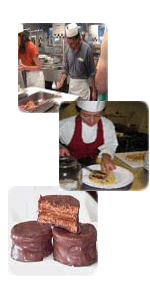



|
As a supplement to our Italian language courses, we also offer Italian cooking courses for professionals and for non-professionals.
Professional Cookery Courses
For those interested in a professional career as a chef, pizza maker, pastry chef, gourmet or sommelier, the school offers the possibility to attend professional courses at an High Italian cooking school. The courses are available on request only for schools and groups (at least 10 people).
All of our courses are based around fundamental cookery techniques and methods that can be applied whether you’re working in a professional kitchen or entertaining at home.
Everything we do at the cookery school is underpinned by a desire to promote food that has been grown in a way that is sustainable, environmentally sensitive, ethical and supportive of local business.
We offer:
Professional catering courses
Pastry chef
Fish, shells and cold dishes in Apulia cuisine
Pasta, Soups and Risotti and Apulia cuisine
Cakes
KURS ITALIJANKSE KUHINJE ZA AMATERE
Izmedju ostalih nasih kurseva nudimo i kurs italijanske kuhinje za one koji nisu profesionalni kuvari.
Za one koji vole italijanske specijalitete i zele da nauce da spremaju tipicna italijanska ili salentinsa jela (predjela, testenine, meso, ribu, povrce, pizze, kolace i td) ILS pruza prakticne kurseve u malim grupama.
Ovaj kurs moze biti rezervisan unapred a odvija se tokom cele godine. Broj casova bira sam polaznik.
Ovaj kurs mozete pohadjati jedino u kombinaciji sa jednim od nasih kurseva italijanskog jezika.
Italian, Apulian and Salentine Gastronomy:
The Turcinieddhri
All people are crazy for the turcinieddhi, the olives of the bowles of the suckling calfs, that are refined and, at the same time, bitterish.
It is employed only the bowels of suckling calfs to make the turcinieddhi. the sucking calfs must never graze.
Their preparation is very simple. The bowles are washed with the water. Then, after having put them for a few hours in the water and lemmon juce, they are stuffed with the animals internal organs like the heart, the lungs and the liver, minced. It is make use of the fat, that winds the lamb's stomac: the peritonaeum membrane. With a little of parsley and salt, the turcinieddhi are ready to be grilled. In the restaurants they are very required. But also the families in their home eat a lot of turcinieddhi, especially in the week-end.
In the nearly all Salento, their name is turcinieddhi. But in some countries their name is gnomarieddhi. The Salento's turcinieddhi are short, in Calabria and Sardegna are long. Wild mushroom crostini
This Italian dish is extremely popular because of its versatility: it can be served as a snack or an antipasto,or with drinks. Crostini can be topped with chicken liver patè, a mixture of tomato, mozzarella and basil, or grilled vegetables. This version using wild mushrooms is exceptionally good - even if you can't get hold of any wild mushrooms and have to use cultivated instead. For the photograph we used chicken of the wood, horn of plenty, brown caps or chestnut mushrooms and oyster mushrooms.
INGREDIENTS (serves four people):
400g mixed wild mushrooms
(whatever you can get)
2 garlic cloves,
1 finely chopped
1 small fresh red chilli, finely chopped
8 tbsp olive oil
1 tbsp coarsely chopped parsley
1tbsp marjoram leaves (to replace the nepitalla or wild mint used in Tuscany)
4 large slices Pugliese bread
salt and pepper to taste
Clean the mushrooms thoroughly and cut them all into cubes. Fry the finely chopped garlic and chilli in 6 tablespoons of the olive oil, and before the garlic starts to colour, add the mushrooms. Sautè or stir-fry them brie.y for a few minutes only so that they retain their crisp texture. Add the parsley, marjoram and some salt and pepper. Meanwhile toast the slices of bread on both sides, then rub them very slightly with the whole garlic clove. Brush with the remaining olive oil and top with the mushrooms. Serve immediately.
The scapece
... But what is the scapece?
It is a typical recipe of Gallipoli, made with little fishes.
The fishes are fried in olive-oil and covered with bread crumbs, vinegard and saffron.
The scapece is often eaten with the celery. Infact often the celery's sellers are near the scapece's sellers.
It is an unique sensation to associate the sweet taste of the celery with the strong of the scapece.
| |
 |
|

